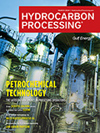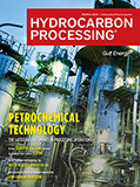Reactors
Hydrocarbon Processing 2021 Awards WINNERS
<i>Hydrocarbon Processing</i>, the downstream processing sector’s leading technical publication for nearly 100 yr, has announced the winners for its fifth annual <i>HP</i> Awards, which celebrate innovative technologies and people that have been instrumental in improving facility operations over the past year.
Hydrocarbon Processing 2021 Awards FINALISTS
<i>Hydrocarbon Processing</I>, the downstream processing sector’s leading technical publication for nearly 100 yr, has announced the finalists for its fifth annual <i>HP</i> Awards, which celebrate innovative technologies and people that have been instrumental in improving facility operations over the past year.
Business Trends: How to achieve industrial autonomy in the refining and petrochemical industries
The process industries are moving from automated to autonomous operations.
Enhanced unit monitoring enabled by digital twin
Process engineers must continuously monitor the health and performance of process units.
Implementation of advanced level control techniques in refinery operations
Plant performance depends on stable operations, with steady feed, product flow, temperature and pressure control as per process requirements.
Oil refinery/petrochemical integration in a CO2-constrained world—Part 2
Petrochemical demand will increase with gross domestic product, while the demand for motor fuels will only show modest growth and may even decline in certain regions, given environmental/legislative pressures and the introduction of battery-powered electric vehicles.
Oil refinery/petrochemical integration in a CO2-constrained world—Part 1
Petrochemical demand will increase with gross domestic product, while motor fuel demand will only show modest growth and may even decline in certain regions, given environmental/legislative pressure and the introduction of battery-powered electric vehicles.
Reverse refining: A novel approach to the refining process
The crude oil refining processing sequence is based on the separation of distillate products from heavier ones and concentrating the heavy molecules of the barrel for processing at the end of the refining run.
Ethylbenzene plant debottleneck with a high-activity transalkylation catalyst
Modern commercial ethylbenzene (EB) plants use liquid-phase alkylation processes with zeolite catalysts to achieve high product yields.
Key instrumentation technologies to tackle the toughest measurement challenges
Just as some people seek out extreme sports, process manufacturing has its extreme applications, and engineers who design for these environments must find ways to safely contain and monitor all manner of dangerous reactions and products.

- China's March jet fuel exports jump 77.4% from a year earlier 4/18
- Nigeria strikes deal with Shell to supply $3.8-B methanol project 4/18
- Singapore fuel oil stockpiles rebound to 8-week high on higher imports 4/18
- Clariant launches new CATOFIN 312 propane dehydrogenation catalyst 4/18
- Solvay inaugurates new blowing agent production unit in Rosignano, Italy 4/18
- Meridian Energy Group’s Davis Refinery Project in North Dakota (U.S.) will be the world’s first net-zero carbon refinery 4/17




